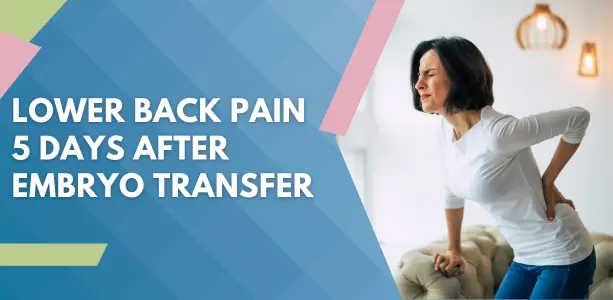Experiencing lower back pain 5 days after embryo transfer is distressing. But, understanding its causes and remedies can offer reassurance and relief. Infertility journeys bring unique challenges and concerns.
Addressing this concern involves recognizing the potential causes. This might range from the physical effects of the procedure to the hormonal changes associated with early pregnancy. Saraogi Hospital is the best IVF centre in Mumbai. It has helped numerous patients through their fertility journey with compassion and expertise.
Dr. Mohit Saraogi is an esteemed infertility specialist in Mumbai. He explains,” Effective remedies often include mild exercise, adequate rest, and proper hydration. But, it’s essential to consult with a specialist to ensure the pain isn’t a sign of complications”.
Understanding these aspects can help manage symptoms. They also provide a clearer path forward in the fertility process.
If you are experiencing discomfort or have concerns about lower back pain post embryo transfer, consult with an expert for personalized guidance and support.
Let’s explore the common queries surrounding lower back pain after embryo transfer and understand its implications in detail.
Is Back Pain Normal After Embryo Transfer?

Backache after embryo transfer is a common occurrence. It is usually linked to the body’s response to the procedure. The process of embryo transfer can lead to temporary changes in hormone levels. This may cause discomfort including lower back pain. Additionally, the physical strain endured during the procedure can contribute to muscle tension. This further exacerbates the discomfort. But, lower back pain 5 days after embryo transfer is a common issue that raises many questions.
As an experienced infertility specialist in Mumbai, Dr. Saraogi emphasizes the importance of recognizing the difference between normal discomfort and concerning symptoms.
He says, “Mild to moderate back pain is often expected. It usually goes away on its own. But, severe or long-lasting pain needs attention and evaluation.” Understanding the nuances of this discomfort is important. It can empower individuals to navigate their post-transfer period with confidence.
Seek expert guidance if you’re experiencing persistent or severe back pain after embryo transfer to ensure optimal care and support.
Let’s delve deeper into the factors contributing to back pain after embryo transfer and explore potential remedies for relief.
Severe Back Pain After Embryo Transfer

Severe back pain after an embryo transfer, though uncommon, requires prompt medical attention. Typically, some mild discomfort might be expected as part of the procedure. But if you experience sharp and ongoing lower back pain, it’s important to take it seriously. Such symptoms can be serious. They are especially concerning if they come with high fever, unusual bleeding, or major swelling.
One of the few possible reasons could be ovarian hyperstimulation syndrome (OHSS). It is a condition that occurs when the ovaries overreact to fertility drugs. They begin to swell, causing much pain. It’s crucial to monitor these symptoms closely and report them to your healthcare provider without delay.
Don’t ignore severe back pain post embryo transfer. Consult with a professional to address potential complications and ensure your well-being.
Let’s uncover the warnings associated with severe back pain after embryo transfer and understand when to seek immediate medical attention.
Negative Signs After Embryo Transfer

- Absence of Pregnancy Symptoms:
The absence of symptoms such as nausea or breast tenderness is not a definite sign of a failed transfer. However, some expect these as indicators of early pregnancy due to hormonal changes. - Heavy Bleeding:
Some spotting or light bleeding after embryo transfer can be normal. But, heavy bleeding like a menstrual period might mean the embryo did not implant. - Severe Pain or Cramps:
Mild cramping can be normal, but severe cramps may be a sign of complications such as ectopic pregnancy or other issues. - Negative Pregnancy Test:
A clear no is a negative pregnancy test after the wait your doctor suggests. This is usually about two weeks after the embryo transfer.
Stay vigilant for any negative signs after embryo transfer. Consult with a specialist to address potential complications.
Let’s explore effective strategies for managing lower back pain after embryo transfer and promoting overall well-being during this critical period.
Remedies to Alleviate Lower Back Pain After Embryo Transfer
Here are some remedies to alleviate lower back pain after embryo transfer:
- Rest and Relaxation:
Avoid strenuous activities and ensure ample rest to support recovery. - Warm Compresses:
Use a warm compress on your lower back to relax muscles and reduce pain. - Gentle Exercise:
Engage in light exercises like walking or prenatal yoga, but consult your doctor first. - Proper Posture:
Keep your back supported and maintain good posture to avoid additional strain. - Hydration:
Drink plenty of fluids to keep tissues hydrated and elastic. - Massage:
Consider gentle massage from a qualified therapist to ease muscle tension.
Get professional advice and care. Consult with a professional today!
Let’s navigate through effective remedies for relieving lower back pain post embryo transfer and promoting a smooth recovery process.
When to Seek Medical Attention for Lower Back Pain 5 Days Post Embryo Transfer
If you experience any of the following, seek medical attention promptly:
- Severe Pain: If the back pain is severe and does not improve with rest, it’s important to consult with a healthcare provider.
- Accompanying Symptoms: If the back pain is accompanied by other symptoms such as fever, vaginal bleeding, severe abdominal pain, or unusual vaginal discharge, these could be signs of infection or complications related to the embryo transfer.
- Persistent Pain: If the pain does not improve or worsens over time, it’s important to seek medical advice. Persistent or increasing pain could indicate underlying issues that may need medical intervention.
- Pain that Interferes with Daily Activities: If the back pain is debilitating and affects your ability to perform daily activities, it’s advisable to consult a healthcare provider.
- Previous Medical History: If you have a history of back problems, other medical conditions, or concerns about the embryo transfer, discuss your symptoms with a healthcare provider
If you have any concerns or unusual symptoms, don’t hesitate to consult with an expert for guidance and support.
Conclusion
Experiencing lower back pain five days post-embryo transfer is relatively common among fertility patients. While mild discomfort can be expected and may resolve independently, it’s essential to stay vigilant for severe or persistent pain, which could signify a need for medical attention.
Dr. Mohit Saraogi together with his dedicated team at Saraogi Hospital, best IVF Doctor in Mumbai, provides comprehensive care and expert guidance tailored to each patient’s needs. He ensures that all his patients receive the support necessary to navigate this phase with confidence.
Saraogi Hospital is one of the most preferred fertility centres that offers all the latest advancements in reproductive technologies, such as ICSI, IMSI, and frozen embryo transfer treatment in Mumbai.
FAQ
How should I feel 5 days after embryo transfer?
Five days after an embryo transfer, it’s common to experience mild discomfort, but overall, you should feel relatively normal.
How long does lower back pain typically last after embryo transfer?
Lower back pain after an embryo transfer typically resolves within a few days, but it can last up to a week or more depending on individual factors.
Can stress or anxiety exacerbate lower back pain after embryo transfer?
Yes, stress or anxiety can exacerbate lower back pain after an embryo transfer, as they can increase muscle tension and sensitivity to pain.
Can certain sleeping positions alleviate lower back pain after embryo transfer?
Yes, sleeping in certain positions, such as on your side with a pillow between your knees, can help alleviate lower back pain after an embryo transfer.

